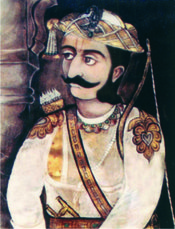
Gondwana, also known as Gondaranya, the land of Gondwana, is a region of India named after the Gondi people who live there. The name of the ancient continent of Gondwanaland was derived from Gondwana, because some of the earliest rock formations of this continent were first investigated in part of the region in modern Odisha.

Chhindwara district is one of the major districts of Madhya Pradesh state of India, and Chhindwara town is the district headquarters. Chhindwara was the largest district in Madhya Pradesh with an area of 10,293 square km before the bifurcation of Pandhurna district. The district is part of Jabalpur division.

The Kingdom of Nagpur was an Indian kingdom within the Maratha Confederacy in the 18th and 19th centuries. It came under the rule of the Marathas of the Bhonsle dynasty in the mid-18th century. The city of Nagpur was the capital of the state.

Raghoji I was a Maratha general of the Bhonsle clan who established the Nagpur Kingdom in much of east-central India during the reign of Chhatrapati Shahu I. His successors ruled the kingdom until 1853.

Raghuji II or Raghuji was the Maratha ruler of the Kingdom of Nagpur in Central India from 1788 to 1816.

Narnala Fort or Narnala Qila Sarkar, also known as Shahnoor Fort, is a hill fortress in the Satpura Range of Vidarbh, Maharashtra, India, named after the Rajput Solanki Chaulukya Ruler, Raja Narnal Singh, also known as Narnal Singh Swami. It was renamed as "Shahnoor" by Islamic rulers but again acquired, rebuilt and got its name "Narnala" by ruler Rao Rana Narnal Singh Solanki, who migrated from Patan in Gujarat.

The history of Nagpur, in central India, spans over 5,000 years, including the Kingdom of Nagpur in the 18th and 19th century. Human existence around present-day Nagpur city can be traced back 3,000 years to the 8th century BC. Menhir burial sites at Drugdhamna indicate megalithic culture existed around Nagpur and is still followed in present times.
The Rajgonds are the ruling class of the Gonds. The region of Gondwana consisted of neighbouring kingdoms. To the south was the Kingdom of Chanda and to the north was the powerful Garha-Mandla kingdom. In the 16th century, the Kingdom of Deogarh rose as a powerful state with the Kherla Kingdom in its western past.

Bakht Buland Shah was a ruler of the Rajgond dynasty. He added to his kingdom, the territories of Chanda and Mandla, and portions of Nagpur, Balaghat, Seoni, Bhandara and the adjoining Rajput kingdom of Kherla/Khedla. The present districts of Chhindwara and Betul also fell under his control. A great warrior, he went on to conquer Pauni, Dongartal, Sivni, and Katangi.

Mudhoji I was the ruler of the Nagpur kingdom from 1772 to 1788. During his regency the Maratha kingdom remained peaceful and prospered.
The Gondwana Kingdoms were the ruling kingdoms in the Gondwana region of India. The Gondwana region includes the core region of the eastern part of the Vidarbha of Maharashtra, Garha Kingdom, the parts of Madhya Pradesh immediately to the north of it, and parts of westerm Chhattisgarh. The wider region extends beyond these, also including parts of northern Telangana, western Odisha and southern Uttar Pradesh.

The Garha Kingdom, also called Garha Mandla or Garha Katanga, was an early-modern-era kingdom in India. It was the first large kingdom to be founded by the Gond tribe and dominated much of Central India at its peak.

Islam is the second largest religion in Maharashtra, India, comprising 12,971,152 people which is 11.54% of the population. Muslims are largely concentrated in urban areas of the state, especially in Mumbai and the Marathwada region. There are several groups of Muslims in Maharashtra: Marathi and Konkani Muslims, whose native language is various dialects of Marathi and Konkani, Dakhni Muslims, whose native language is Dakhni Urdu, and more recent Urdu-speaking migrants from North India.

The Bhonsles of Nagpur were a Maratha royal house that ruled the Kingdom of Nagpur from 1739-1853. They hailed from the Bhonsle clan of Marathas and were one of the most important and powerful Maratha chiefs in the Maratha Empire.

The Gonds of Deogarh were a Gond royal house that ruled large parts of the Vidarbha region and parts of present-day southern Madhya Pradesh. Their Kingdom consisted of the area which later became the Nagpur Kingdom. They made Nagpur region a prosperous and plentiful kingdom, founding the city of Nagpur and building further infrastructure. However, internal bickering led to their decline and they were practically made state pensioneries by the Maratha general Raghoji I Bhonsle in the 1743.
Raghunath Singh was the Diwan of the Gond king of Deogarh. He tried to unsuccessfully overthrow Raghuji Bhonsla's sway with the help of the Gond king of Chandrapur, Nilkanth Shah.
The Kingdom of Chanda was one of the main Gond kingdoms, ruling parts of central India. In 1751, it was conquered by the Maratha ruler of Nagpur, Raghoji I Bhonsle.
Mohan Singh was the last ruler of the Haihaiyavanshi Kingdom, the dynasty which ruled Chhattisgarh for over 700 years. He ruled Chhattisgarh under the suzerainty of the Bhonsles of Nagpur Kingdom.
Baka Bai was a Maratha stateswoman and favourite wife of Raghoji II Bhonsle, the king of Nagpur. After her husband's death, she played a key role in the intrigues at the royal court of Nagpur.

The Bhonsle dynasty is an Indian Marathi royal house. The Bhonsles claimed descent from the Rajput Sisodia dynasty, but were likely Kunbi Marathas.














